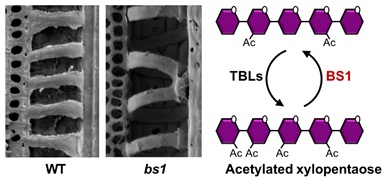Plant cell wall is a characteristic cellular structure of plant cells, which not only plays important roles in morphogenesis, organ development, and nutrition transport, but also provides supports for erect growth and adaptations to various environmental circumstances. In addition, plant cell wall represents one of the most abundant renewable resources, which products serve us as daily foods and materials.
O-acetylation, a ubiquitous modification of cell-wall polymers, has striking impacts on plant growth and biomass utilization. It is proposed that acetyl-esters mediate the interlinking between polymers, which is essential for maintenance of wall architecture. The acetyl-ester profile on polysaccharides varies in different plant tissues and developmental stages, suggesting that acetylation modification is tightly controlled. To dynamically maintain a certain acetyl-ester level, the plants need to be able to both acetylate and deacetylate, so deacetylases that work antagonistically to acetyltransferases likely exist in plant cells. However, such an enzyme has not been reported.
The group of Prof. ZHOU Yihua and the group of Prof. CHU Chengcai from the Institute of Genetics and Developmental Biology, Chinese Academy of Sciences (CAS), recently reported that BS1 is a xylan deacetylase and functions in removal of acetyl-esters from xylan backbone, which is crucial for secondary wall formation and patterning. This work has been published in
Nature Plants on March 3, 2017 (
DOI: 10.1038/nplants.2017.17).
They isolated and characterized a
brittle leaf sheath1 (
bs1) mutant in rice, which contains lesion in a GDSL esterase that deacetylates the prominent hemicellulose xylan. Cell wall composition and xylan structure characterizations showed that the mutant xylans contain increased wall-bound acetyl esters. Enzyme kinetics and activity assays on acetylated sugars and xylooligosaccharides demonstrate that BS1 is a xylan deacetylase, which specifically
cleaves acetyl moieties from the xylan backbone at
O-2 and
O-3 position of xylopyranosyl residues. The enzymatic products were further confirmed by liquid chromatography-mass spectroscopy and nuclear magnetic resonance analyses. Moreover,
BS1 is preferentially expressed in secondary wall-enriched vascular bundles and sclerenchyma cells. Mutation in this protein led to impaired secondary wall patterning and abnormal growth phenotypes.
It is the first time to reveal that the acetyl-ester profile control involves the process of deacetylation and occurs in polysaccharide biosynthesis, which outlines
a new mechanism---bidirectional regulation model, and endows
a plethora of uncharacterized GDSL esterases with surmisable activities. Moreover, this study elucidated the importance of acetylation modification in maintenance of cell wall architecture and its function. The relevant genes might be used in agronomic trait improvement and crop breeding.
Prof. Henrik V. Scheller from Lawrence Berkeley National Laboratory commented this work in the same issue of
Nature Plants and pointed out that this work has many surprises and let us know “Plant cell wall: Never too much acetate” (
DOI: 10.1038/nplants.2017.24).
This research was supported by the National Natural Science Foundation of China, the Ministry of Science and Technology of China, Chinese Academy of Sciences, and Youth Innovation Promotion Association CAS, as well as the State Key Laboratory of Plant Genomics.
Figure 1. Xylan deacetylase BS1 regulates secondary wall formation and agronomic traits in rice. A GDSL esterase BS1 deacetylates the prominent hemicellulose xylan, which modulates secondary cell wall patterning and affects agronomic traits. (Image by IGDB)
 Figure 1. Xylan deacetylase BS1 regulates secondary wall formation and agronomic traits in rice. A GDSL esterase BS1 deacetylates the prominent hemicellulose xylan, which modulates secondary cell wall patterning and affects agronomic traits. (Image by IGDB)CONTACT:
Figure 1. Xylan deacetylase BS1 regulates secondary wall formation and agronomic traits in rice. A GDSL esterase BS1 deacetylates the prominent hemicellulose xylan, which modulates secondary cell wall patterning and affects agronomic traits. (Image by IGDB)CONTACT: CAS
CAS
 中文
中文




.png)
